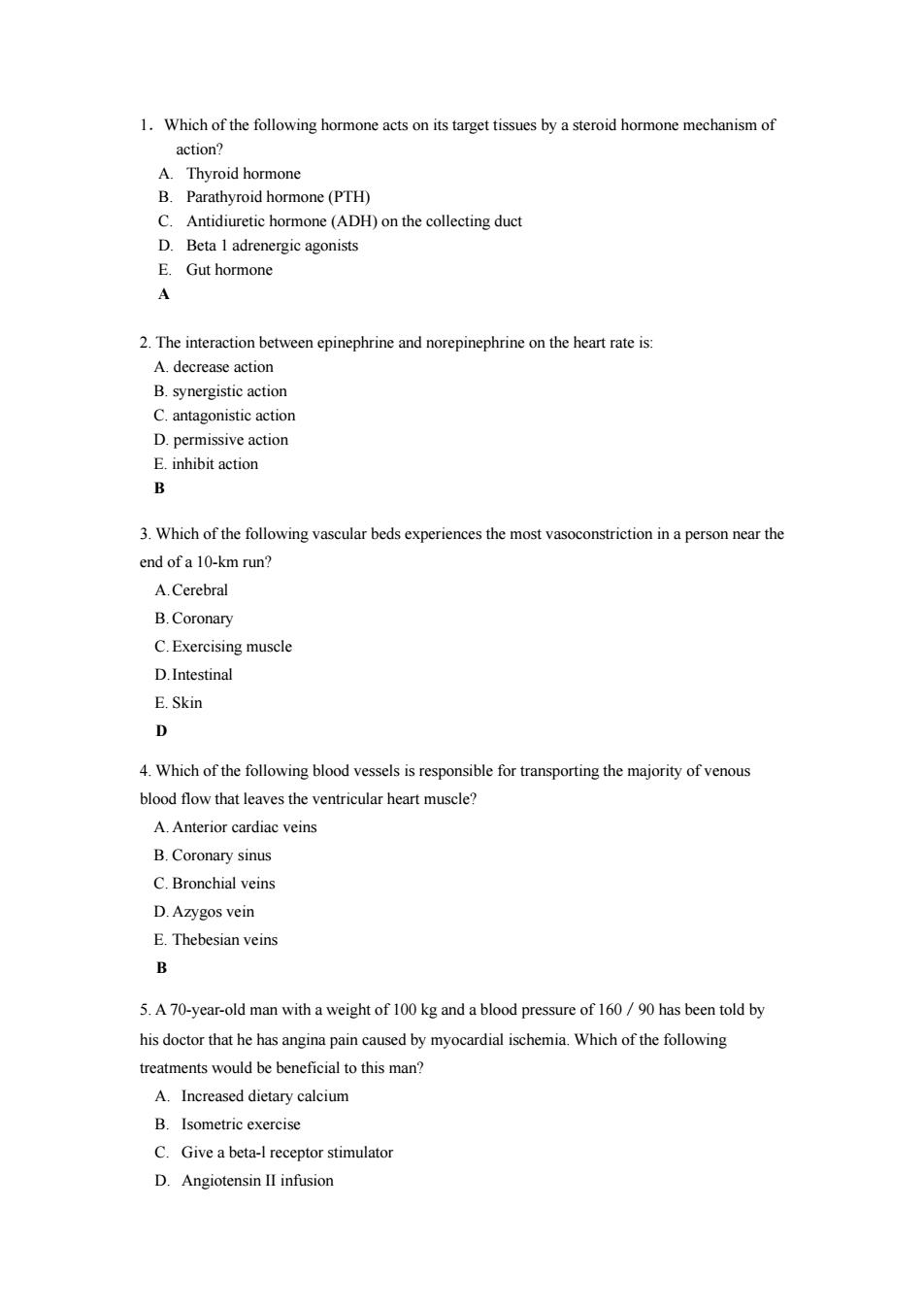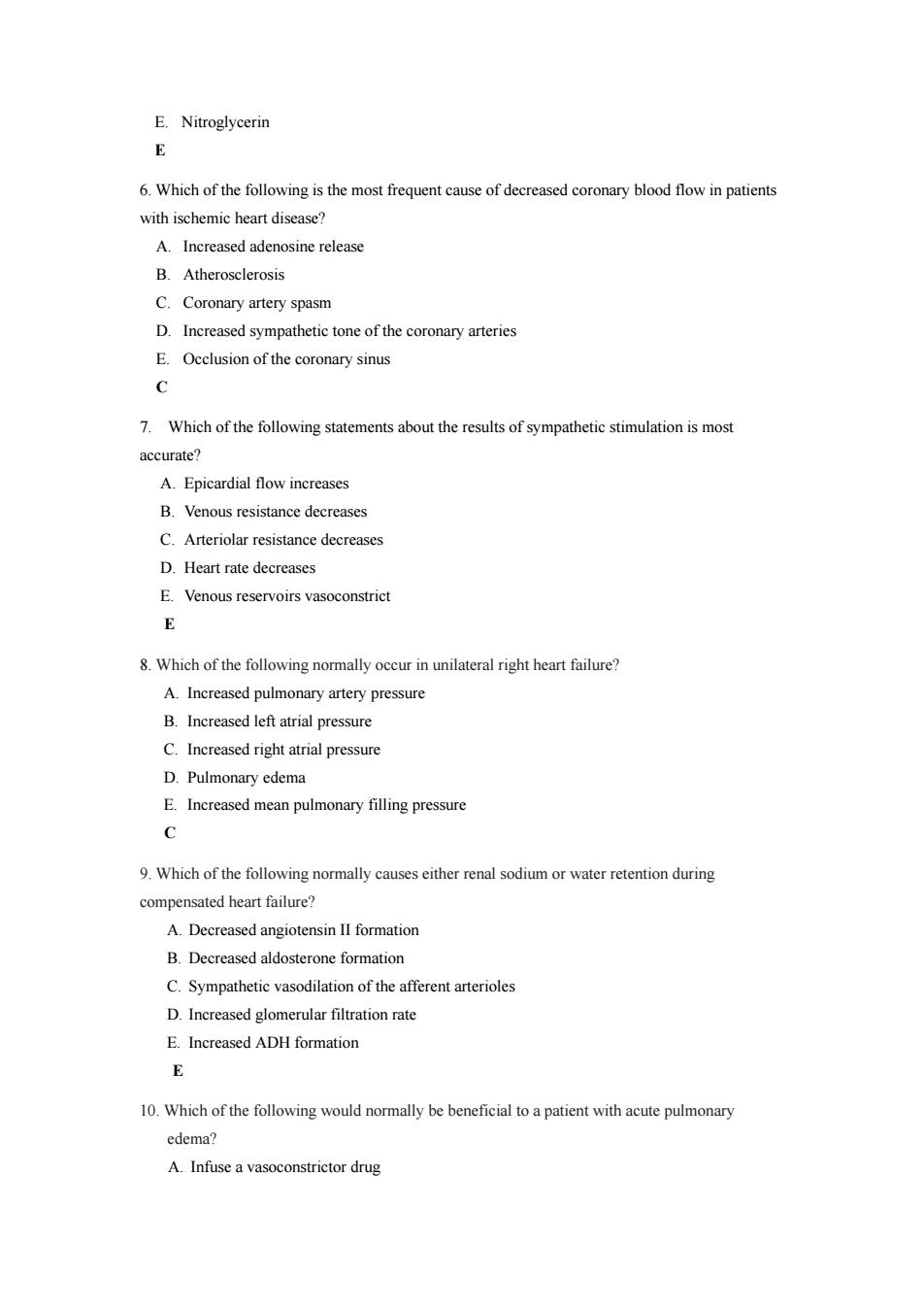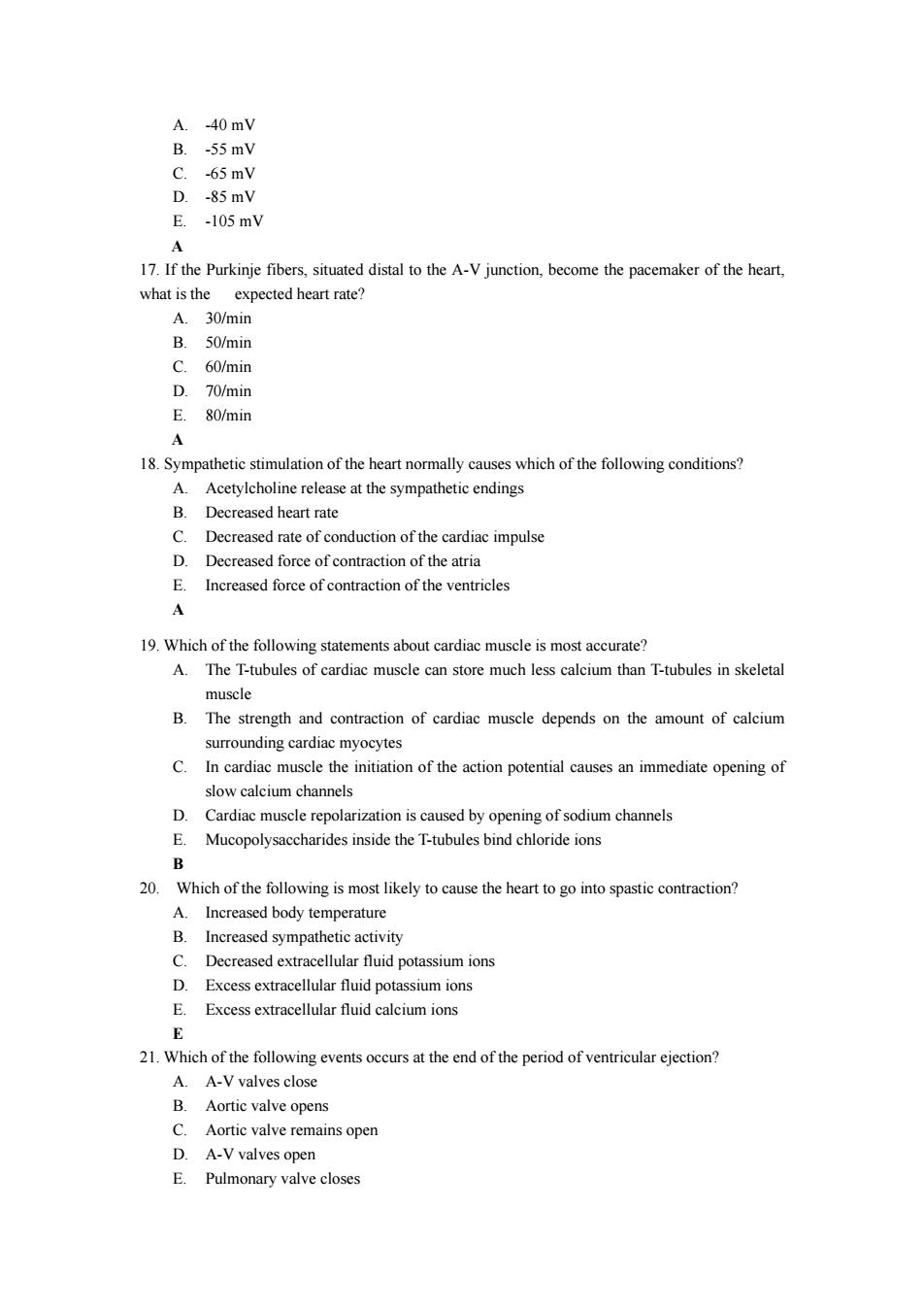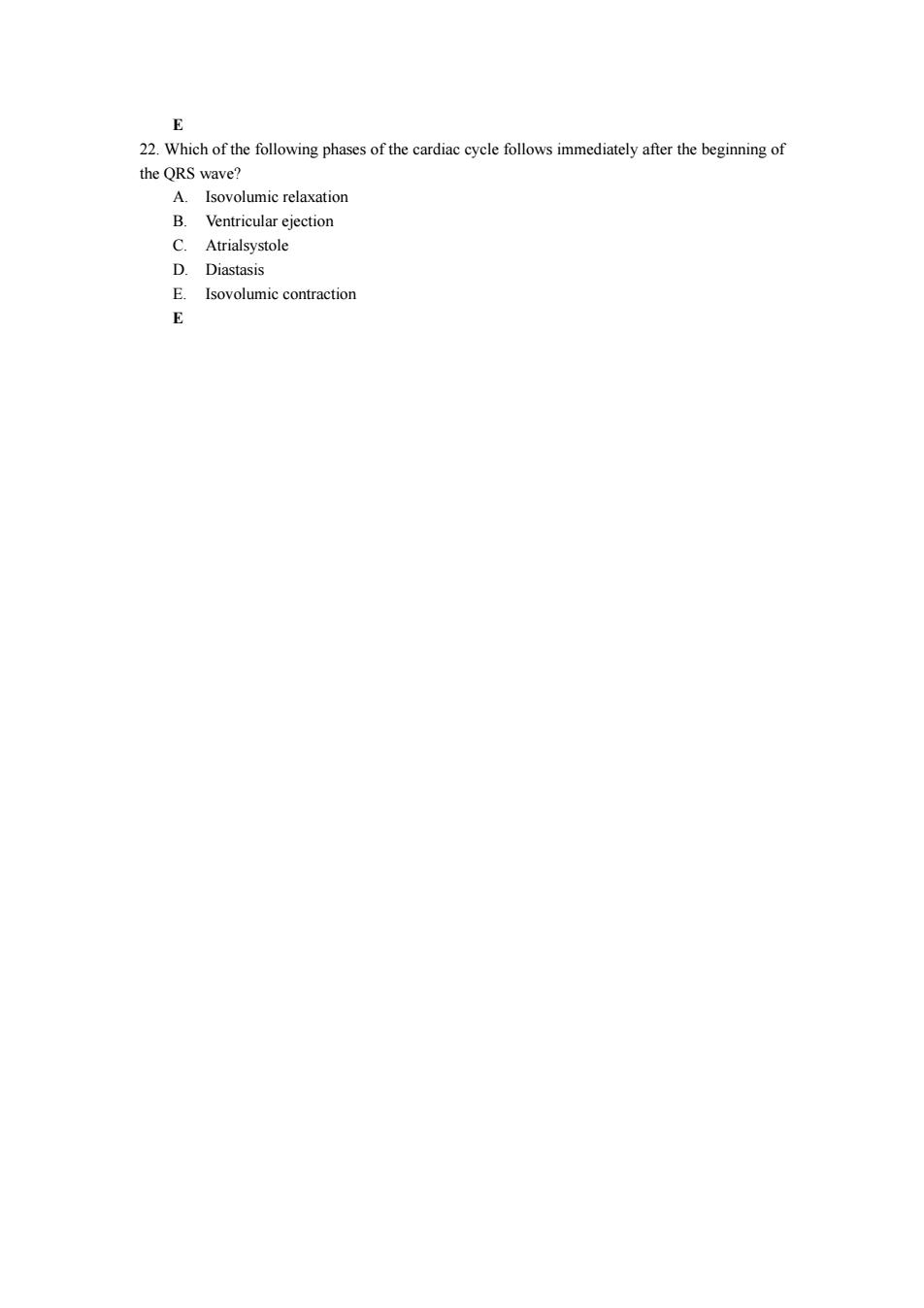
1.Which of the following hormone acts on its target tissues by a steroid hormone mechanism of action? Thyroid hormon B.Parathyroid hormone(PTH) C.Antidiuretic hormone (ADH)on the collecting duct D.Beta I adrenergic agonists E Gut hormone 2.The interaction between epinephrine and norepinephrineon the heart rate is: A.decrease action B.synergistic action C.antago D.permissive action E.inhibit action B 3.Which of the following vascular beds experiences the most vasoconstriction in a person near the end ofa 10-km run? A.Cerebral B.Coronary C.Exercising muscle D.Intestinal E.Skin D 4.Which of the following blood vessels is responsible for transporting the majority of venous blood flow that leaves the ventricular heart muscle? A.Anterior cardiac veins B.Coronary sinus C.Bronchial veins D.Azvgos vein E.Thebesian veins R 5.A 70-year-old man with a weight of 100 kg and a blood pressure of 160/90 has been told by his doctor that he has angina pain caused by myocardial ischemia.Which of the following treatments would be beneficial to this man? A.Increased dietary calcium B.Isometric exercise C.Give a beta-l receptor stimulator D.Angiotensin II infusion
1.Which of the following hormone acts on its target tissues by a steroid hormone mechanism of action? A. Thyroid hormone B. Parathyroid hormone (PTH) C. Antidiuretic hormone (ADH) on the collecting duct D. Beta 1 adrenergic agonists E. Gut hormone A 2. The interaction between epinephrine and norepinephrine on the heart rate is: A. decrease action B. synergistic action C. antagonistic action D. permissive action E. inhibit action B 3. Which of the following vascular beds experiences the most vasoconstriction in a person near the end of a 10-km run? A.Cerebral B.Coronary C.Exercising muscle D.Intestinal E. Skin D 4. Which of the following blood vessels is responsible for transporting the majority of venous blood flow that leaves the ventricular heart muscle? A. Anterior cardiac veins B. Coronary sinus C. Bronchial veins D. Azygos vein E. Thebesian veins B 5. A 70-year-old man with a weight of 100 kg and a blood pressure of 160/90 has been told by his doctor that he has angina pain caused by myocardial ischemia. Which of the following treatments would be beneficial to this man? A. Increased dietary calcium B. Isometric exercise C. Give a beta-l receptor stimulator D. Angiotensin II infusion

E.Nitroglycerin E 6.Which of the following is the most frequent cause of decreased coronary blood flow in patients with ischemic heart disease? A.Increased adenosine release B.Atherosclerosis C.Coronary artery spasm D.Increased sympathetic tone of the coronary arteries E.Occlusion of the coronary sinus 7.Which of the following statements about the results of sympathetic stimulation is most accurate? A.Epicardial flow increases B.Venous resistance decreases C.Arteriolar resistance decreases D.Heart rate decreases E.Venous reservoirs vasoconstric e 8.Which of the following normally occur in unilateral right heart failure? A.Increased pulmonary artery pressure B.Increased left atrial pressure C.Increased right atrial pressur D.Pulmonary edema E.Increased mean pulmonary filling pressure C 9.Which of the following normally causeseither renal sodiumor water retention during compensated heart failure? A.Decreased angiotensin II formation B.Decreased aldosterone formation C.Sympathetic vasodilation of the afferent arterioles D.Increased glomerular filration rate E.Increased ADH formation E 10.Which of the following would normally be beneficial to a patient with acute pulmonary edema? A.Infuse a vasoconstrictor drug
E. Nitroglycerin E 6. Which of the following is the most frequent cause of decreased coronary blood flow in patients with ischemic heart disease? A. Increased adenosine release B. Atherosclerosis C. Coronary artery spasm D. Increased sympathetic tone of the coronary arteries E. Occlusion of the coronary sinus C 7. Which of the following statements about the results of sympathetic stimulation is most accurate? A. Epicardial flow increases B. Venous resistance decreases C. Arteriolar resistance decreases D. Heart rate decreases E. Venous reservoirs vasoconstrict E 8. Which of the following normally occur in unilateral right heart failure? A. Increased pulmonary artery pressure B. Increased left atrial pressure C. Increased right atrial pressure D. Pulmonary edema E. Increased mean pulmonary filling pressure C 9. Which of the following normally causes either renal sodium or water retention during compensated heart failure? A. Decreased angiotensin II formation B. Decreased aldosterone formation C. Sympathetic vasodilation of the afferent arterioles D. Increased glomerular filtration rate E. Increased ADH formation E 10. Which of the following would normally be beneficial to a patient with acute pulmonary edema? A. Infuse a vasoconstrictor drug

B.Infuse a balance electrolyte solution C.Give furosemide D.Give a bronchoconstricto E.Infuse whole blood 11.An of the following would tend to increase in which increase lymph flow? A.Hydraulic conductivity of the capillary wall B.Plasma colloid osmotic pressure D.Arteriolar resistance E.Aand C E mainly by which of the following? A.Sympathetic nerves B.Angiotensin II C.Vasopressin D.Metabolic needs E.Capillary osmotic pressure D 13.If the S-A node discharges at 0.00 seconds,when will the action potential normally arrive at the epicardial surface at the base of the left ventricle? A.0.22se B018e 0.16 sec D.0.12sec E.0.09 sec 14.Which of the following? repinephrine】 Increased sodium permeability C.Increased calcium permeability D.Increased potassium permeability E.Decreased acetylcholine levels 15.Which of the following are caused by acetylchoine A.Hyperpolarization of the S-A node B.Depolarization of the A-V node C.Decreased permeability of the S-A node to potassium ions D.Increased heart Increased permeability of the cardiac muscle tocalcium ion 16.Which is the membrane potential (threshold level)at which the S-A node discharges?
B. Infuse a balance electrolyte solution C. Give furosemide D. Give a bronchoconstrictor E. Infuse whole blood C 11. An of the following would tend to increase in which increase lymph flow? A. Hydraulic conductivity of the capillary wall B. Plasma colloid osmotic pressure C. Capillary hydrostatic pressure D. Arteriolar resistance E. A and C E 12. Under normal physiological conditions, blood flow to the skeletal muscles is determined mainly by which of the following? A. Sympathetic nerves B. Angiotensin II C. Vasopressin D. Metabolic needs E. Capillary osmotic pressure D 13. If the S-A node discharges at 0.00 seconds, when will the action potential normally arrive at the epicardial surface at the base of the left ventricle? A. 0.22sec B. 0.18 sec C. 0.16 sec D. 0.12sec E. 0.09 sec A 14. Which of the following conditions at the S-A node will cause heart rate to decrease? A. Increased norepinephrine levels B. Increased sodium permeability C. Increased calcium permeability D. Increased potassium permeability E. Decreased acetylcholine levels D 15. Which of the following are caused by acetylcholine? A. Hyperpolarization of the S-A node B. Depolarization of the A-V node C. Decreased permeability of the S-A node to potassium ions D. Increased heart rate E. Increased permeability of the cardiac muscle to calcium ions A 16. Which is the membrane potential (threshold level) at which the S-A node discharges?

A.40mV B.-55mV -65 mV ,85my E.-105mV A 17.If the Purkinje fibers,situated distal to the A-V junction,become the pacemaker of the heart. what is the expected heart rate? 30/min B.50/min C.60/min D.70/min E.80/min 18.Sympathetic stimulation of the heart normally causes which of the following conditions? A.Acetylcholine release at the sympathetic endings B.Decreased heart rate C.Dec eased rate of conduction of the cardiac impulse D.De Increas sed force of contraction of the ventricles A 19.Which of the following statements about cardiac muscle is most accurate? A The t-tubules of cardiac muscle can store much less calcium than t-tubules in skeletal muscle B The strength and contraction of cardiac muscle depends on the amount of calcium surrounding cardiac myocytes C.In cardiac muscle the initiation of the action potential causes an immediate opening of slow calcium channels D.Cardiac is caused by opening of sodium channels Mucopolysaccharides inside the T-tubules bind chloride ions 20. Which of the following is most likely to cause the heart to go into spastic contraction? A.Increased body temperature Decreased Excess extracellular fluid potassium ions E.Excess extracellular fluid calcium ions E 21.Which of the following events occurs at the end of the period of ventricular ejection? A A-V valves close B Aortic valve opens Aortic valve remains open D.A-V valves open E.Pulmonary valve closes
A. -40 mV B. -55 mV C. -65 mV D. -85 mV E. -105 mV A 17. If the Purkinje fibers, situated distal to the A-V junction, become the pacemaker of the heart, what is the expected heart rate? A. 30/min B. 50/min C. 60/min D. 70/min E. 80/min A 18. Sympathetic stimulation of the heart normally causes which of the following conditions? A. Acetylcholine release at the sympathetic endings B. Decreased heart rate C. Decreased rate of conduction of the cardiac impulse D. Decreased force of contraction of the atria E. Increased force of contraction of the ventricles A 19. Which of the following statements about cardiac muscle is most accurate? A. The T-tubules of cardiac muscle can store much less calcium than T-tubules in skeletal muscle B. The strength and contraction of cardiac muscle depends on the amount of calcium surrounding cardiac myocytes C. In cardiac muscle the initiation of the action potential causes an immediate opening of slow calcium channels D. Cardiac muscle repolarization is caused by opening of sodium channels E. Mucopolysaccharides inside the T-tubules bind chloride ions B 20. Which of the following is most likely to cause the heart to go into spastic contraction? A. Increased body temperature B. Increased sympathetic activity C. Decreased extracellular fluid potassium ions D. Excess extracellular fluid potassium ions E. Excess extracellular fluid calcium ions E 21. Which of the following events occurs at the end of the period of ventricular ejection? A. A-V valves close B. Aortic valve opens C. Aortic valve remains open D. A-V valves open E. Pulmonary valve closes

22.Which of the following phases of the cardiac eycle follows immediately after the beginning of the RS wave? A.Isovolumic relaxatior B.Ventricular ejection C.Atrialsystole D.Diastasis Isovolumic contraction E
E 22. Which of the following phases of the cardiac cycle follows immediately after the beginning of the QRS wave? A. Isovolumic relaxation B. Ventricular ejection C. Atrialsystole D. Diastasis E. Isovolumic contraction E